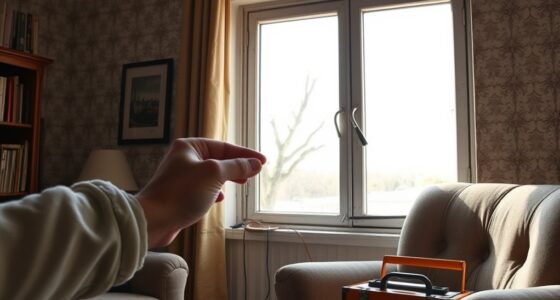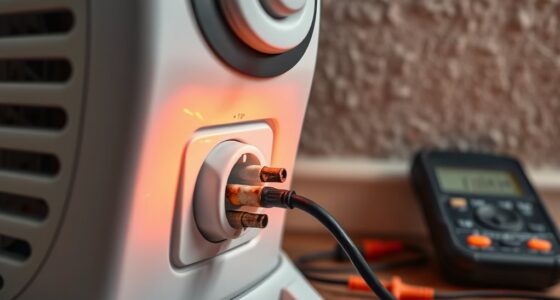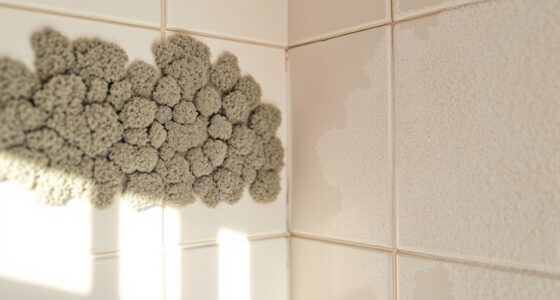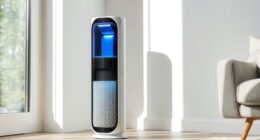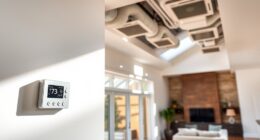Dust mites hate humidity levels above 50%, so keeping your indoor humidity between 30% and 50% is key. Use a dehumidifier or air conditioner to lower moisture, making your environment less hospitable for mites. Regularly maintaining ideal humidity reduces their food sources and limits their growth. Combining humidity control with air purifiers equipped with HEPA filters can considerably cut down on allergens. Keep going to discover more effective strategies to create a healthier, mite-free space.
Key Takeaways
- Maintain indoor humidity levels between 30% and 50% to inhibit dust mite growth.
- Use dehumidifiers or air conditioners to consistently lower moisture in your home.
- Regularly monitor humidity levels with a hygrometer for optimal control.
- Reducing humidity makes environments less hospitable for dust mites and their food sources.
- Combining humidity control with air purifiers enhances allergen removal and creates an inhospitable environment for mites.

Have you ever wondered why dust mites thrive in your home? It’s because they love warm, humid environments where they can feed on skin flakes and thrive. To keep these tiny pests at bay, controlling humidity is essential, but it’s not enough to just lower moisture levels—you also need to consider air quality. An air purifier can be a game-changer here, especially one equipped with HEPA filters, as it helps with allergen reduction by capturing dust mite debris, skin flakes, and other microscopic particles that trigger allergies. This combination of humidity control and air purification creates an environment less hospitable to dust mites, making your home healthier and more comfortable.
When humidity levels hover above 50%, dust mites find it easy to multiply. They breathe and feed comfortably in these conditions, which means your chances of allergic reactions increase. Using a dehumidifier or air conditioner helps bring humidity down to a more manageable level—ideally between 30% and 50%. This range is uncomfortable for dust mites, but tolerable for humans, so you’ll notice fewer allergy symptoms and less dust mite activity. The goal is to create a dry environment that discourages mite survival without making your home uncomfortably cold or dry for you.
An air purifier plays a crucial role in allergen reduction by filtering out tiny particles that often carry dust mite allergens. These devices can trap microscopic debris that settle on furniture, bedding, and carpets, which are common sources of dust mite allergens. When you run an air purifier regularly, you’re actively reducing the amount of allergenic material floating in the air, which benefits allergy sufferers considerably. Pairing this with humidity control means you’re attacking dust mites on multiple fronts—removing their food source and creating an environment they can’t easily survive in.
Additionally, implementing AI-powered air quality monitoring can help optimize humidity and filtration settings automatically, ensuring your environment remains inhospitable for dust mites at all times.
Many people overlook the importance of air quality when trying to combat dust mites. But it’s clear that a good air purifier, combined with proper humidity levels, can make a noticeable difference. Not only does this approach reduce dust mite populations, but it also improves your overall indoor air quality, helping you breathe easier. By maintaining lower humidity and filtering the air effectively, you’re preventing dust mites from thriving and minimizing the allergens they produce. This simple yet powerful combination offers a practical solution to one of the most persistent home allergens, giving you a cleaner, healthier living space.
Frequently Asked Questions
Can Humidity Control Eliminate Dust Mites Completely?
Humidity control considerably reduces dust mites, but it might not eliminate them entirely. By maintaining indoor humidity below 50%, you can lower allergy triggers and improve air quality, making your environment less hospitable for dust mites. However, some mites may still persist in hidden areas. To effectively manage allergy symptoms, combine humidity regulation with regular cleaning and air filtration. This approach creates a healthier space and minimizes dust mite-related issues.
What Is the Ideal Humidity Level to Prevent Dust Mites?
Ever wonder how to keep dust mites at bay? The ideal humidity level to prevent them is between 30-50%. Dust mite biology shows they thrive in moist environments, so controlling humidity with accurate measurement is key. Don’t let high moisture levels invade your space—maintain this range to reduce their population. Are you ready to create a less allergenic home? Proper humidity control makes all the difference.
Are There Any Risks Associated With Low Humidity Environments?
Lowering humidity can help reduce allergy triggers and dust mites, but going too low risks mold growth and dry skin. You might experience respiratory irritation or worsen allergy symptoms if the environment becomes overly dry. To avoid these risks, maintain a balanced humidity level between 40-50%. Use a dehumidifier carefully, and monitor humidity to prevent mold and keep allergy triggers at bay.
How Quickly Can Humidity Control Reduce Dust Mite Populations?
Think of humidity control as your secret weapon—within a few days, you can markedly reduce dust mite populations. Lowering humidity to below 50% slows mold growth and eases allergy symptoms. If you act fast, you might notice improvements in just a week. Keep in mind, consistent control is key; otherwise, dust mites and mold might bounce back, making your environment less healthy.
Does Humidity Control Work for All Types of Bedding and Furniture?
Humidity control works well for most bedding materials and furniture types, but effectiveness varies. For bedding, using hypoallergenic covers and moisture barriers enhances results. When it comes to furniture, opting for non-upholstered or sealed pieces helps reduce dust mite habitats. You should also maintain humidity levels below 50%, ensuring your environment stays less inviting for dust mites across different bedding materials and furniture types.
Conclusion
By keeping your home’s humidity in check, you’ll make life much harder for dust mites—no more sneezing fits or itchy eyes. It’s like giving them a one-way ticket to the dustbin of history, just like the pharaohs’ secret tombs kept out invaders. So grab a humidifier or dehumidifier, set it just right, and enjoy a fresher, healthier space. Trust me, your sinuses will thank you, and you’ll feel ready to face the world, just like a true modern-day Cleopatra.



